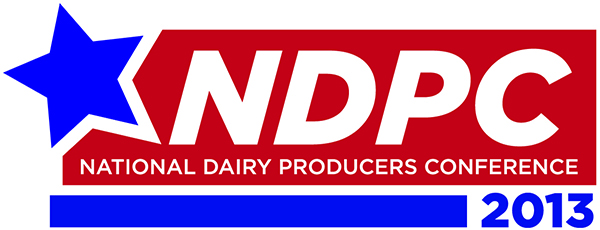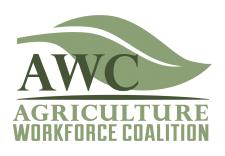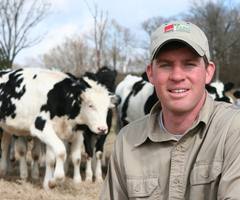 The outlook for a new farm bill, and a better safety net for dairy farmers, will be one of the key sessions at the upcoming National Dairy Producers Conference (NDPC) April 7 – 9 in Indianapolis, Indiana.
The outlook for a new farm bill, and a better safety net for dairy farmers, will be one of the key sessions at the upcoming National Dairy Producers Conference (NDPC) April 7 – 9 in Indianapolis, Indiana.
The conference, open to dairy farmers from across the country, will provide an in-depth discussion of the issues facing the dairy industry, with educational discussions on topics ranging from farm policy to immigration reform to agricultural finance. The meeting is organized by NMPF.
On Monday, April 8th, a two-hour session will address the prospects in 2013 for the NMPF-backed dairy reforms contained in the 2012 Farm Bill. That session will feature presentations from congressional staff, NMPF leadership, and agricultural economists – all discussing the outlook for getting the Dairy Security Act (DSA) passed this year, and how that measure would benefit farmers. Although the DSA came close to passage at the end of 2012, the agriculture committees in the House and Senate will have to restart the farm bill process this spring. The NDPC panel will review how that process will unfold, and will examine why a dairy margin insurance program with market stabilization will provide better financial protection for farmers compared to current programs.
“The National Dairy Producers Conference is the only forum where dairy farmers from across America can meet together and have in-depth discussions about the policy issues affecting them,” said Jerry Kozak, President and CEO of NMPF. “There’s no shortage of major challenges right now in our business. The focus of this conference is on addressing solutions for the future.”
In addition to reviewing the farm bill, the conference will include another session about the prospect for immigration reform legislation on Capitol Hill, with presentations from individuals representing dairy farmers, the White House and Congress. The National Dairy Producers Conference will also examine the state of the agricultural banking sector as it relates to dairy farming. A trade policy panel will address how the U.S. can both protect and promote its dairy products in world markets, while a panel on dairy cow marketing will focus on the marketing of cull dairy cows.
Guest speakers at the NDPC include Purdue agricultural economist Christopher Hurt, who will review the outlook for feed prices this year, and Bill Weldon of Elanco, who will discuss new ideas under development for products to enhance a dairy cow’s productivity.
The NDPC sessions will be preceded by an optional farm tour that will take place on Sunday, April 7th. Participants will be able to get an insider tour of Fair Oaks Farms, one of the largest dairies in the country, with a consumer education facility.
Although the conference is geared primarily toward dairy producers, anyone with a stake in the dairy industry is invited to attend. This may include dairy cooperative executives and directors, dairy processors, suppliers and consultants to the dairy industry, state and federal regulators, promotion organization executives, and academics.
The deadline to make hotel reservations is March 14th. For more information on the NDPC, including how to register, visit www.nmpf.org/NDPC.

 Dairy farmers continued in 2012 to improve their already stellar track record of keeping antibiotic residues out of the milk supply, with the most recent national survey finding that only 0.017% of all bulk milk tankers, or 1 in 6,000 loads, showed any sign of an animal antibiotic drug residue. On-farm vigilance in following drug withdrawal times has led to a steady decline in antibiotic residue, falling from an already low level of 0.061% in 2002, a decline of nearly 75% in the last decade.
Dairy farmers continued in 2012 to improve their already stellar track record of keeping antibiotic residues out of the milk supply, with the most recent national survey finding that only 0.017% of all bulk milk tankers, or 1 in 6,000 loads, showed any sign of an animal antibiotic drug residue. On-farm vigilance in following drug withdrawal times has led to a steady decline in antibiotic residue, falling from an already low level of 0.061% in 2002, a decline of nearly 75% in the last decade. NMPF continues to work with other national and state farm groups on reforms to America’s immigration policies that would allow for the future flow of workers on dairy farms and the opportunity for existing workers that may lack legal documentation to continue working on dairy farms.
NMPF continues to work with other national and state farm groups on reforms to America’s immigration policies that would allow for the future flow of workers on dairy farms and the opportunity for existing workers that may lack legal documentation to continue working on dairy farms. Congress’ failure to pass a farm bill last year is proving costly. New preliminary cost estimates from the Congressional Budget Office (CBO) have revised upward the price tag of the farm bills that moved through the House and Senate last year. The bills still show budget savings over current farm programs – saving billions of dollars over a ten-year period – but the projected savings have been reduced by new economic projections.
Congress’ failure to pass a farm bill last year is proving costly. New preliminary cost estimates from the Congressional Budget Office (CBO) have revised upward the price tag of the farm bills that moved through the House and Senate last year. The bills still show budget savings over current farm programs – saving billions of dollars over a ten-year period – but the projected savings have been reduced by new economic projections. Last month, the U.S. Farmers & Ranchers Alliance (USFRA®), a coalition of which NMPF is a member, announced that dairy farmer Will Gilmer (left) from Sulligent, AL, had been selected as one of four winners in its Faces of Farming & Ranching program, a nationwide search launched in summer 2012 to help put real faces on the American agriculture industry
Last month, the U.S. Farmers & Ranchers Alliance (USFRA®), a coalition of which NMPF is a member, announced that dairy farmer Will Gilmer (left) from Sulligent, AL, had been selected as one of four winners in its Faces of Farming & Ranching program, a nationwide search launched in summer 2012 to help put real faces on the American agriculture industry



